It was hot; now it’s not.
After two decades, is the trend of building fine fescue-based golf courses in America creeping to a halt?
The list of U.S. resort courses blanketed with fine fescue reads like a Top 100 party - Bandon Dunes and Silvies Valley Ranch in Oregon; The Loop at Forest Dunes in Michigan; The Prairie Club in Nebraska; Gamble Sands and Chambers Bay in Washington state; and Sand Valley, Whistling Straits and Erin Hills in Wisconsin. That’s 370 holes spread across 23 courses in five states. Combined, these facilities have hosted three PGA Championships, two U.S. Opens and three U.S. Amateurs. Impressive stuff, especially when you consider how rare it is for modern, publicly accessible courses to steal such high-profile events from established private clubs.
That success rate seems to imply that any developer who mixes the magic ingredients of fine fescue turf with a talented architect virtually ensures the project will be a resounding success. It’s not that simple. Just ask the superintendents at Erin Hills and Chambers Bay. Both prominent U.S. Open sites have waged turf wars where struggling fescue fairways (Erin Hills) and greens (Chambers Bay) have cost them rounds, revenue and plenty of money to make repairs.
The problem is that fine fescue can be as fickle as the weather without perfect conditions in the soil and the sky. Fine fescue only really thrives on a sandy site. There are questions that need to be addressed before facilities go the fine fescue route, but the opportunity for bouncy, firm turf that golfers and architects crave is often too appetizing to turn down. Plus, once it's established, fine fescue requires less water and fertilizer than other surfaces.
“I believe that it (building fescue-dominated courses in America) will continue to be tried, especially farther north if the sites are right for it,” said Darin Bevard, the director of Championship Agronomy for the USGA Green Section who has worked extensively with Chambers Bay, Bandon Dunes and Erin Hills. “It’s proven to be difficult to manage, unless you have well-drained, sandy soils on a golf course.”
The origins of fescue in America

Jealousy is a powerful motivator. America's golf industry has always been envious of its European and Australian counterparts who have access to links golf every day. Playing golf while walking firm fescue fairways in windy conditions along the sea has always felt like the purest form of the game.
Bill Coore and Ben Crenshaw were the pioneers who brought linksy golf to America by designing the Sand Hills Golf Club in, of all places, Mullen, Neb. Its 1995 opening is now considered a turning point in modern architecture, launching a minimalist movement that continues to this day. This style of architecture is all about taking what the land gives and creating playability and options around complex greensites, replacing the penal architecture of the previous era. People often forget, though, that the addition of fescue turf has been a vital part of that equation at many of the most celebrated modern projects. You can't have courses that play like a links without firm, bouncy fairways. No grass does it better.
"I personally think it’s the finest golfing turf surface ever," Coore said. "Even to this day, I know of no other turf that enables the ball to react so well like it does on fescue fairways."
From Sand Hills, fescue sprouted upon courses in every direction except farther south, where it won't last in hot, humid summers.
Pete Dye was the first to introduce fescue fairways to America's resort golf scene. It debuted on the Straits course in 1998, one year before Bandon Dunes' original course by David McLay Kidd. The fairways and primary rough at both Whistling Straits courses are a blend of three fescue cultivars, according to the resort website, while the deep rough is a blend of four. A cultivar is a variety of plant, in this case fescue, created by selective breeding.
As the popularity and collection of links courses at Bandon Dunes grew, other resort developers jumped on the fescue train to create their own linksy playgrounds ... Erin Hills (2006), Chambers Bay (2007), The Prairie Club (2010), Gamble Sands (2014), The Loop (2016), Silvies Valley Ranch (2017) and Sand Valley (2017). Architect Tom Doak also installed it in 2006 at Ballyneal, a private club destination in Colorado, and seven years later at Dismal River's Red course, another private club destination in Mullen, Neb.
Not every inland links built during this era went the fescue route, though. Streamsong's courses in central Florida rely on wide, rolling fairways seeded with Bermuda 419. The Red and Blue courses opened in 2012 with MiniVerde greens, but have been re-grassed this summer with a new Bermudagrass named Mach One. Trump Golf Links at Ferry Point in the Bronx boasts bentgrass on both its fairways (Bentgrass Seaside 2) and greens (007 Creeping Bent), surrounded by wispy fescue to make it look like a links.
"You can have firm and fast bentgrass as well," Bevard said. "You will need more aggressive fairway topdressing and aeration programs (for it to happen). When you think of the top courses, a lot of them have creeping bentgrass. It can be managed to be firm and fast. If it rains, it won't be firm and fast. From a playability standpoint, it will be very good. It will be different (than fescue) but still be very good."
The problems with fescue
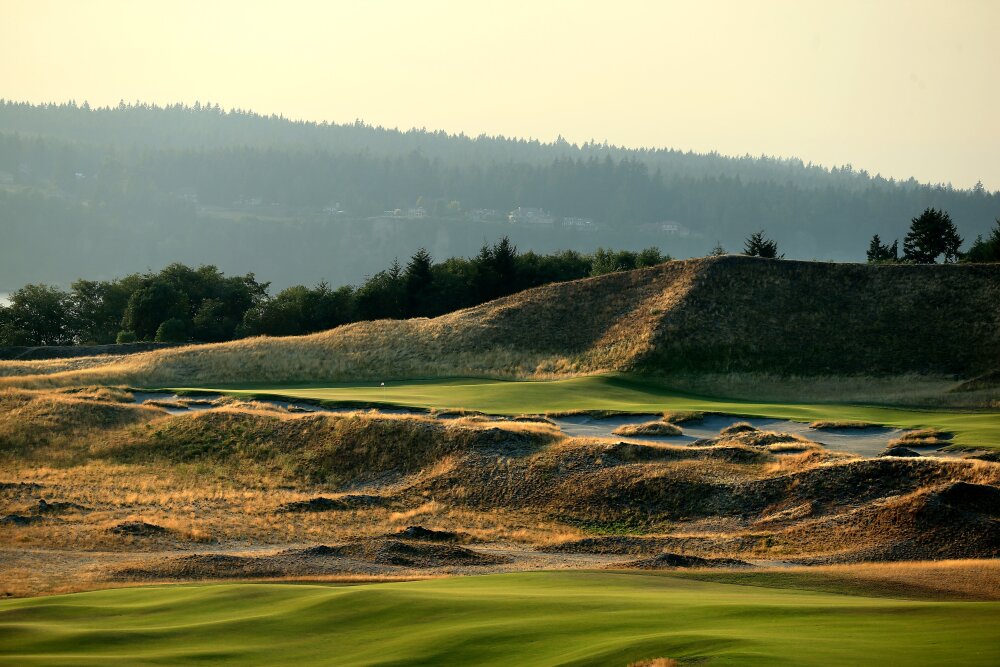
Maintaining wall-to-wall fescue is proving to be very difficult in America.
Everybody, of course, remembers the controversial 2015 U.S. Open at Chambers Bay. From day one, the Robert Trent Jones II course on the edge of the Puget Sound had trouble keeping consistent green speeds. The fescue on the greens had to be kept long and shaggy to promote growth. It infuriated visitors who would shell out hundreds of dollars to play the course and experience greens slower than their local muni.
During the tournament, the pros griped about the speed of the greens and fiery fairways that fostered difficult-to-control approach shots. It was the talk of the week, and maybe even played a major role in who won. Dustin Johnson three-putted the final green to lose to Jordan Spieth.
By the end of the 2018 season, Chambers Bay finally relented, transitioning its greens to the grass of choice in the Pacific Northwest, poa annua. The move has been widely praised. "They are much improved. The sod work they did, it went very well," Bevard said.
Not even Bandon Dunes - the posterchild for fine fescue in America - is wall-to-wall everywhere anymore. The greens of the resort's highly regarded trio - Pacific Dunes, Bandon Dunes and Bandon Trails - all gradually transitioned to poa. Old MacDonald, Bandon Preserve and the new Sheep Ranch will hold onto their fescue greens as long as possible, according to Ken Nice, the resort's director of agronomy. He said it took Pacific Dunes 13 years to make the transition.
"You can find poa on the greens on the Sheep Ranch (already)," he said. "It is hard to keep the stuff out. It takes a foothold in this climate. There are not any environmental checks to keep it out. It's not hot enough or cold enough" to kill the poa.
Meanwhile in the Midwest, the fairways are the issue at Erin Hills. It has decided to replace its fine fescue fairways with bentgrass, reseeding all 18 holes this summer. When completed, only the long rough will be fescue, bumping Erin Hills from the exclusive fine fescue club. The fairways at Silvies Valley Ranch (fine fescue and Kentucky bluegrass) and The Prairie Club (three strains of fescue and Colonial Bentgrass) are a mix of grasses.
Bevard said inconsistent soil at Erin Hills is to blame. "The perception is that it is a sandy site. There are some areas that way, but also some heavy clay soils," Bevard said. "In those areas, the fescue does not perform well. Over time, they used Rye grass just to have grass (in those spots). That worked well, but then there were problems with winterkill. It creates a problem early in the season. Zach Reineking (the superintendent at Erin Hills), he's been fighting a bentgrass invasion back for five to six years."

Another quirk of fine fescue is it doesn't like carts. That's why most of these facilities are walking-only. The Loop at Forest Dunes, a reversible routing by Doak, just started allowing carts last year. Some wonder how the turf will handle the impact long term.
"Fescue can take foot traffic, but it doesn’t like carts, particularly on a large volume basis," Coore said. "If you have cart traffic, it is not the grass of choice. A lot of it (its success) has to do with how it is maintained. It takes a different mindset than other grasses. You just have to approach it and manage it different. When you do, it is the best."
Costly renovation projects like those at Erin Hills and Chambers Bay, no doubt, have raised red flags about the future of fescue-based projects in America. There's one potentially brewing at Pacific Gales - a project yet to start along the Oregon coast - but other developers and architects would be wise to proceed in planting fine fescue with caution.
The temptation is to look past the risk, though, and see only the reward. Mike Keiser, the man behind Bandon Dunes and Sand Valley, has become a legend in the golf world by following a resort model that works: Building walking-only courses with fine fescue turf on sandy sites. Keiser also played a major role in developing Cabot Links and Cabot Cliffs, two wall-to-wall fine fescue links courses on Cape Breton Island in Nova Scotia, Canada. Whoever can build the next one successfully could deliver the next big thing in U.S. golf.
How much do you favor the firm-and-bouncy conditions of fescue courses to playing more traditional American golf? Let us know in the comments below.


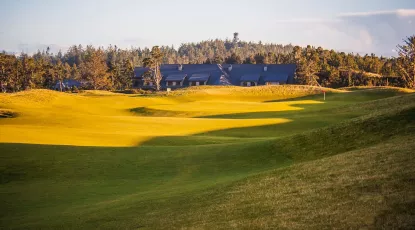
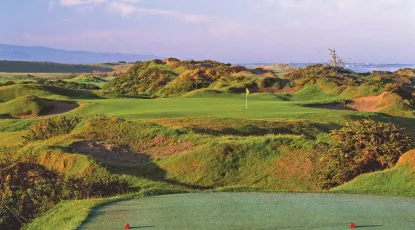
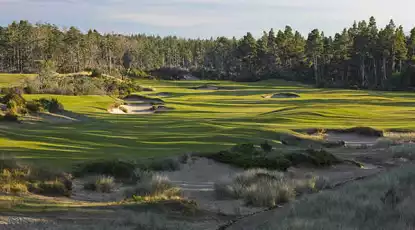
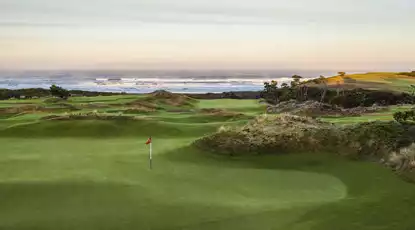
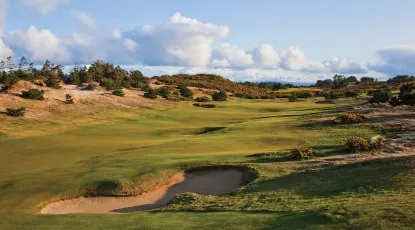
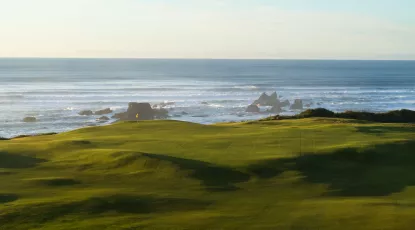




















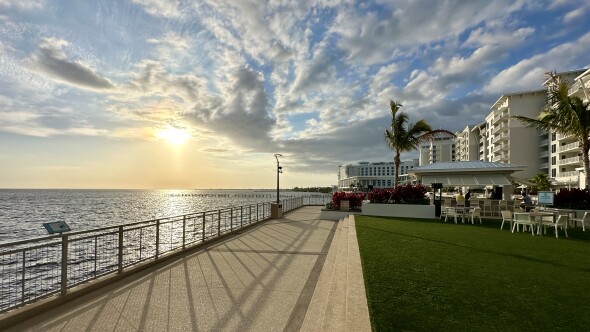



Wonderful, fun and experienced different ways to play golf. Played Gamble Sands two days ago.
Well aware of the "slow greens" at Chambers Bay and Bandon when they had fescue greens. Anything on the west coast especially in Oregon or Washington or in the Puget Sound area like Chambers Bay will eventually become poa. The complaints of slow greens were just a lack of awareness by those playing those greens. Like most links courses in GB&I green speeds need to be limited anyway because of wind at both Bandon and Chambers Bay.